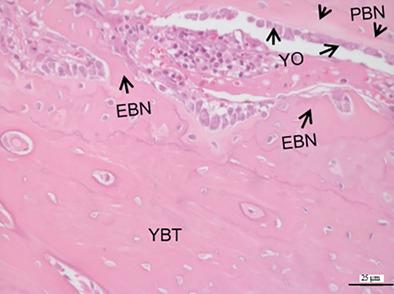当前位置:
X-MOL 学术
›
Microsc. Res. Tech.
›
论文详情
Our official English website, www.x-mol.net, welcomes your
feedback! (Note: you will need to create a separate account there.)
Effect of chitosan and Dysphania ambrosioides on the bone regeneration process: A randomized controlled trial in an animal model.
Microscopy Research and Technique ( IF 2.0 ) Pub Date : 2020-06-04 , DOI: 10.1002/jemt.23512 Elizandra Silva da Penha 1 , Rogério Lacerda-Santos 2 , Luanna Abílio Diniz Melquíades de Medeiros 3 , Rosana Araújo Rosendo 3 , Antonielson Dos Santos 4 , Marcus Vinícius Lia Fook 5 , Wladymyr Jefferson Bacalhau de Sousa 5 , Millena de Oliveira Firmino 6 , Erik Montagna 1
Microscopy Research and Technique ( IF 2.0 ) Pub Date : 2020-06-04 , DOI: 10.1002/jemt.23512 Elizandra Silva da Penha 1 , Rogério Lacerda-Santos 2 , Luanna Abílio Diniz Melquíades de Medeiros 3 , Rosana Araújo Rosendo 3 , Antonielson Dos Santos 4 , Marcus Vinícius Lia Fook 5 , Wladymyr Jefferson Bacalhau de Sousa 5 , Millena de Oliveira Firmino 6 , Erik Montagna 1
Affiliation

|
The focus of this triple‐blind study was on evaluating the effect of chitosan combined with Dysphania ambrosioides (A) extract on the bone repair process in vivo. In total, 60 male Wistar rats (Rattus norvegicus albinus) weighing between 260 and 270 g were randomly selected for this study and distributed into four groups (n = 15). Group C (chitosan), Group CA5 (chitosan + 5% of D. ambrosioides), Group CA20 (chitosan + 20% of D. ambrosioides), and Group CO (Control‐Blood clot). In each animal, bone defects measuring 2 mm in diameter were performed in both tibias for placement of the substances. After 7, 15, and 30 days, the animals were sedated and sacrificed using the cervical dislocation technique and the tissues were analyzed under optical microscope relative to the following events: inflammatory infiltrate, necrosis, osteoclasts, osteoblasts, fibroblasts, periosteal, and endosteal bone formation. The data were evaluated to verify distribution using the Kolmogorov–Smirnov test, and variance, using the Levene test; as distribution was not normal, data were subjected to the Kruskal–Wallis and Dunn nonparametric tests (p < .05). A significant inflammatory infiltrate was observed in Group CA5 (p = .008) in the time interval of 7 days, and in Group C at 15 (p = .009) and 30 (p = .017) days. Osteoblastic activity was more significant in Group CA20 (p = .027) compared with CA5 in the time interval of 7 days. Group CA20 demonstrated a significantly higher endosteal and periosteal bone formation value in the time interval of 7 (p = .013), 15 (p = .004), and 30 days (p = .008) compared with the other groups. The null hypothesis was refuted, bone regeneration was faster in spheres with an association of chitosan and 20% extract, and complete bone repair occurred clinically at 15 days and histologically at 30 days. The spheres proved to be a promising method for the biostimulation of alveolar bone repair and bone fractures.
中文翻译:

壳聚糖和 Dysphania ambrosioides 对骨再生过程的影响:动物模型中的随机对照试验。
这项三盲研究的重点是评估壳聚糖联合Dysphania ambrosioides (A) 提取物对体内骨修复过程的影响。总共 60 只体重在 260 至 270 g 之间的雄性 Wistar 大鼠(Rattusnorvegicus albinus)被随机选择用于本研究,并分为四组(n = 15)。C 组(壳聚糖)、CA5 组(壳聚糖 + 5% D. ambrosioides)、CA20 组(壳聚糖 + 20% D. ambrosioides)和 CO 组(对照血块)。在每只动物的双侧胫骨中进行直径为 2 毫米的骨缺损,以放置物质。7、15和30天后,使用颈椎脱位技术对动物进行镇静和处死,并在光学显微镜下分析组织的以下事件:炎症浸润、坏死、破骨细胞、成骨细胞、成纤维细胞、骨膜和骨内膜骨形成。使用 Kolmogorov-Smirnov 检验评估数据以验证分布,使用 Levene 检验评估数据的方差;由于分布不正态,数据接受了 Kruskal-Wallis 和 Dunn 非参数检验 ( p < .05)。CA5 组 ( p = .008) 在 7 天的时间间隔内观察到显着的炎症浸润,C 组在 15 ( p = .009) 和 30 ( p = .017) 天的时间间隔内观察到明显的炎症浸润。在 7 天的时间间隔内,与 CA5 组相比,CA20 组的成骨细胞活性更为显着 ( p = .027)。与其他组相比, CA20 组在 7 天 ( p = .013)、15 天 ( p = .004) 和 30 天 ( p = .008)的时间间隔内表现出显着更高的骨内膜和骨膜骨形成值。零假设被驳斥,在壳聚糖和 20% 提取物结合的球体中,骨再生更快,并且临床上在 15 天时发生完全骨修复,在组织学上在 30 天时发生完全骨修复。事实证明,这些球体是一种用于牙槽骨修复和骨折生物刺激的有前途的方法。
更新日期:2020-06-04
中文翻译:

壳聚糖和 Dysphania ambrosioides 对骨再生过程的影响:动物模型中的随机对照试验。
这项三盲研究的重点是评估壳聚糖联合Dysphania ambrosioides (A) 提取物对体内骨修复过程的影响。总共 60 只体重在 260 至 270 g 之间的雄性 Wistar 大鼠(Rattusnorvegicus albinus)被随机选择用于本研究,并分为四组(n = 15)。C 组(壳聚糖)、CA5 组(壳聚糖 + 5% D. ambrosioides)、CA20 组(壳聚糖 + 20% D. ambrosioides)和 CO 组(对照血块)。在每只动物的双侧胫骨中进行直径为 2 毫米的骨缺损,以放置物质。7、15和30天后,使用颈椎脱位技术对动物进行镇静和处死,并在光学显微镜下分析组织的以下事件:炎症浸润、坏死、破骨细胞、成骨细胞、成纤维细胞、骨膜和骨内膜骨形成。使用 Kolmogorov-Smirnov 检验评估数据以验证分布,使用 Levene 检验评估数据的方差;由于分布不正态,数据接受了 Kruskal-Wallis 和 Dunn 非参数检验 ( p < .05)。CA5 组 ( p = .008) 在 7 天的时间间隔内观察到显着的炎症浸润,C 组在 15 ( p = .009) 和 30 ( p = .017) 天的时间间隔内观察到明显的炎症浸润。在 7 天的时间间隔内,与 CA5 组相比,CA20 组的成骨细胞活性更为显着 ( p = .027)。与其他组相比, CA20 组在 7 天 ( p = .013)、15 天 ( p = .004) 和 30 天 ( p = .008)的时间间隔内表现出显着更高的骨内膜和骨膜骨形成值。零假设被驳斥,在壳聚糖和 20% 提取物结合的球体中,骨再生更快,并且临床上在 15 天时发生完全骨修复,在组织学上在 30 天时发生完全骨修复。事实证明,这些球体是一种用于牙槽骨修复和骨折生物刺激的有前途的方法。









































 京公网安备 11010802027423号
京公网安备 11010802027423号